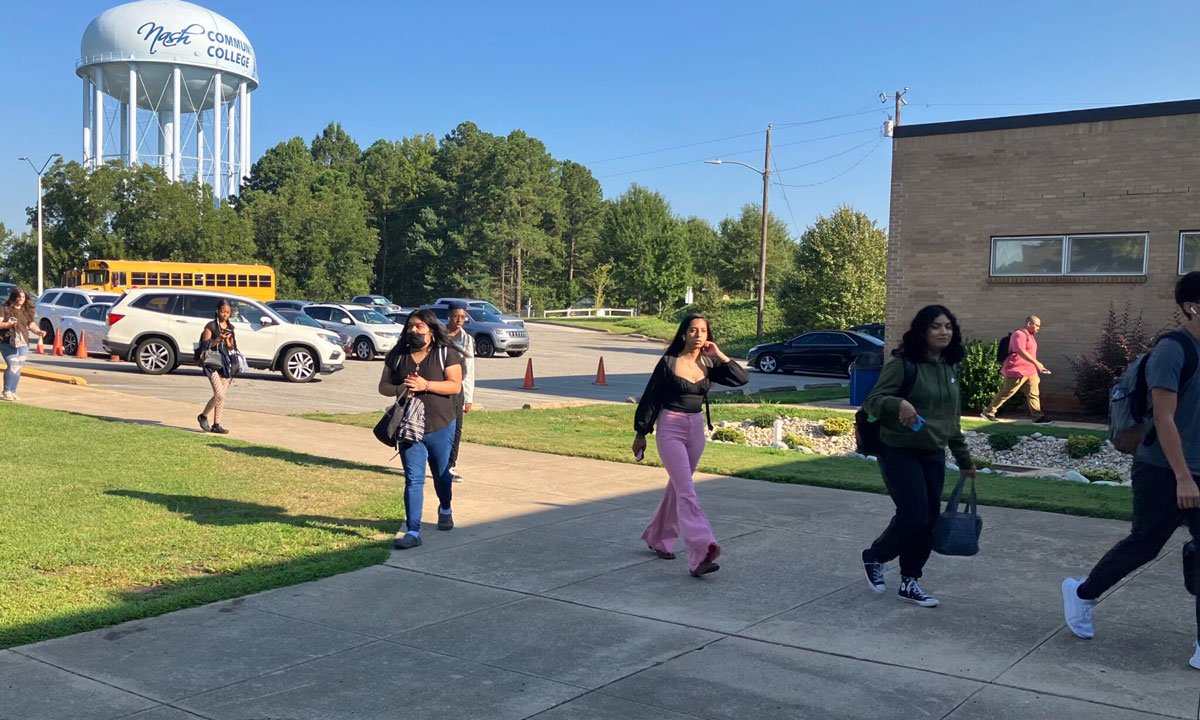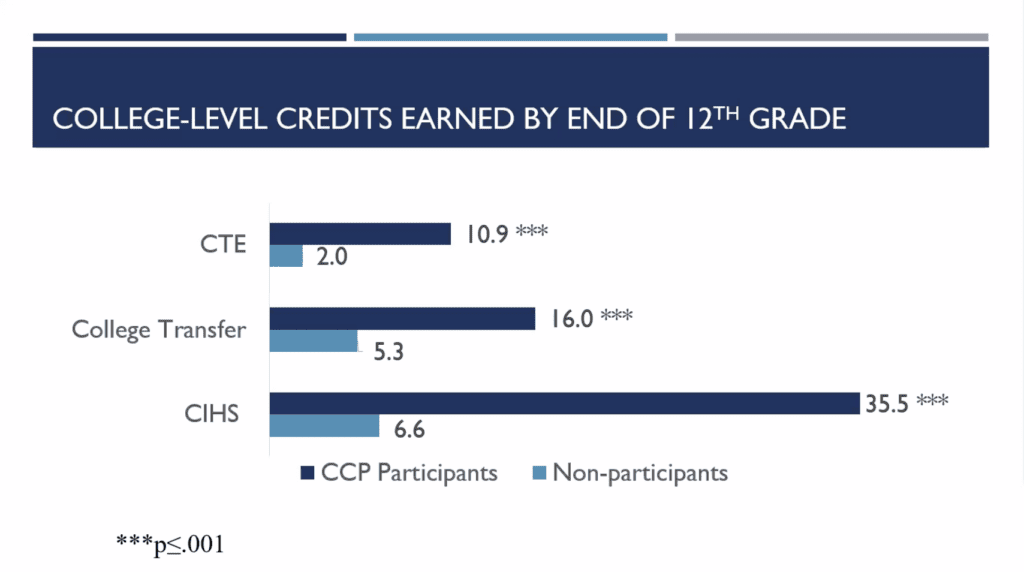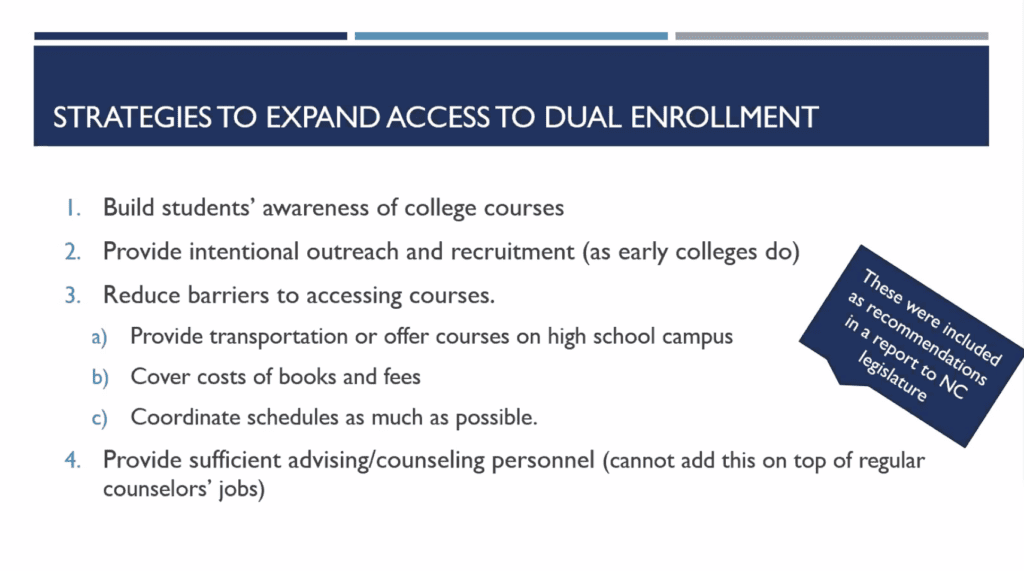North Carolina Conference Highlights Importance of Dual Enrollment
While dual enrollment is particularly beneficial for economically-disadvantaged students, gaps exist in participation and attainment.

Get stories like this delivered straight to your inbox. Sign up for The 74 Newsletter
Hundreds of higher education leaders across the country gathered virtually on Feb. 28-29 for a dual enrollment conference hosted by several North Carolina agencies — the N.C. Community College System (NCCCS), the N.C. Department of Public Instruction (DPI), the University of North Carolina at Greensboro’s Early College Research Center, and the national RAND Corporation.
The conference included more than 30 sessions focused on the benefits of dual enrollment, the need for equity, and strategies to improve and expand programs.
“This is the second conference focused on the role of dual enrollment in unlocking student potential and expanding access to postsecondary education in our state and across the country,” said NCCCS President Dr. Jeff Cox. “We are a leader in the country in dual enrollment, but there’s a lot of interest to expand even further.”
In North Carolina, dual enrollment opportunities for high school students have existed for more than 30 years. The state’s dual enrollment program, Career and College Promise (CCP), was created in 2011 to provide structured opportunities for high school students to earn college credits tuition-free that “lead to a certificate, diploma, or degree as well as provide entry-level jobs skills.”
In recent years, the NCCCS has focused on expanding and strengthening CCP, which includes three pathways: college transfer, career and technical education (CTE), and Cooperative Innovative High Schools (CIHS). The system’s 2022-26 strategic plan includes high school enrollment as a focus of increasing access and enrollment across the state.
At the same time, participation in dual enrollment programs has increased. Last school year, the NCCCS served over 78,000 students in its dual enrollment programs during 2022-23, Cox said. CCP participation among N.C. high schoolers doubled from 6% in 2014-15 to 12% in 2020-21.
State Superintendent Catherine Truitt said dual enrollment is an important part of student success. She said the community college system is crucial to her work of “improving the state’s public schools, expanding innovation, and ensuring that all students are prepared to be enrolled, enlisted, or employed when they graduate.”
Keynote speaker Dr. Karen Stout, president and chief executive officer of Achieving the Dream, urged conference attendees to “rethink access” to dual enrollment.
“Dual enrollment is the fastest-growing segment of community college enrollment,” she said. “We must stretch the boundaries of our thinking about the design of our dual enrollment programs and about the range of partnerships we might develop with K-12 partners to help more students thrive — who without these programs, would never have found their way to college in the first place.”
Stout raised a few themes for participants to think about over the two-day conference.
- The importance of CTE pathways to increase equitable access to dual enrollment.
- Aligning dual enrollment programs with other college offerings in a more strategic manner.
- Articulating a shared vision among partners and then creating a work plan to achieve desired outcomes.
- Focusing on equitable expansion. Specifically, Stout recommended creating culturally-focused and community-specific outreach, engaging prospective students earlier, and bringing advising/classes to students.
“Equity must be at the center of the work to strengthen dual enrollment,” she said. “There is much for us to do, and this is important work at a critical moment. Dual enrollment… must become a centerpiece to our equitable student success agenda.”
Here’s a look at some of the main takeaways from the conference. The graphic below also includes an overview of the three CCP pathways in North Carolina.

Impacts of dual enrollment
Overall, data shows positive impacts of dual enrollment, said Dr. Julie Edmunds, the director of the Early College Research Center at UNC-Greensboro’s SERVE.
Research indicates that CCP programs allow participants to earn postsecondary credentials at higher rates than their peers — with larger benefits for economically disadvantaged students. Edmunds said economically disadvantaged students benefit most in attaining bachelor’s degrees.
Edmunds presented data on college-level credits earned by the end of 12th grade among CCP participants and their peers. You can see that data in the chart below.
“If you don’t see impacts on these college credits, then your program isn’t really doing anything at all,” Edmunds said. “But as you can see from this chart, CCP students earn many more college credits than students in the comparison groups.”
She noted that CIHS involvement has the largest impact on postsecondary attainment among the pathways.

Other benefits of CCP include higher graduation rates and a higher likelihood to earn a credential. That includes any postsecondary credential, certificate, associate degree, and bachelor’s degree.
Among all pathways and credentials, the only negative impact was among CTE participants. Students who participated in CTE were slightly less likely to earn a bachelor’s degree than their peers, Edmunds said.
“This seems to suggest that some students may have been steered away from earning a bachelor’s degree. Is this good, or is this bad?” Edmunds said. “It could be good if students might have learned that their desired career did not require a bachelor’s degree, and therefore they didn’t need to go to a four-year institution. However, we also know that students with bachelor’s degrees earn more over the long haul than students without bachelor’s degrees.”
Rural students also tend to benefit more from CCP participation, Edmunds said.
“(This is) mostly because they don’t have as many alternative options to them for high-level course taking,” she said.
The Belk Center for Community College Leadership and Research’s Dr. Holley Nichols presented on benefits for rural students taking dual enrollment math courses.
North Carolina saw a 45% increase in math dual enrollment courses taken between 2017 and 2022, according to the Belk Center’s research.
“We really saw this incredible uptick that was much sharper than overall engagement in dual enrollment, in math,” said Nichols, the Belk Center’s associate director of research and evaluation.
The center analyzed participation in math dual enrollment courses across the state, focusing on highly transferrable courses like statistical methods, pre-calculus/algebra, and calculus.
They found that math dual enrollment participation was roughly 25% across the board in Tier 1 counties, as ranked by the N.C. Department of Commerce. Each year, the department ranks counties on their economic well-being, with 1 being the most economically distressed and 3 being the least economically distressed.
In rural counties specifically, the rate of participation in math dual enrollment was often higher. This could be due to generally higher rates of math teacher vacancies in rural areas, Nichols said.

In some counties, the rate of math dual enrollment participation was up to 50%, Nichols said.
“In rural areas, the importance of these math dual enrollment classes cannot be underestimated,” Nichols said. “For a lot of these high schools, that is the chance to take upper-level math.”
Despite all the benefits CCP offers, access to dual enrollment is not equitably distributed, conference speakers said. Here is a look at what research says about increasing the equity of dual enrollment.
Equitable expansion
While dual enrollment is particularly beneficial for economically-disadvantaged students, gaps exist in participation and attainment. Those gaps vary across dual enrollment pathways, speakers said, but generally impact Black, Hispanic, and male student populations.
In the college transfer pathway, Edmunds said an additional gap exists among economically disadvantaged students.
Many gaps exist because colleges are not intentional about outreach, she said.
“When you just sort of make an opportunity available to people, who are the people who are going to take advantage of that?” Edmunds said. “Well, they’re going to be the people that are already super motivated… or their parents are super motivated. People who come with all of those inherent supports and advantages, those are going to be the people who are going to take advantage of it first.”
Conference speakers, including Edmunds, emphasized several strategies to advance equity in dual enrollment: the importance of strong K-12 partnerships, academic and non-academic supports, and early career/academic exploration.
Edmunds also shared several recommendations on expanding access to dual enrollment, included below.

Sarah Griffin, a research associate with Columbia University’s Community College Research Center (CCRC), shared the center’s equity framework, dual enrollment equity pathways (DEEP).
DEEP is “a research-based framework for rethinking dual enrollment as a more equitable on-ramp to college programs of study that lead to family-supporting, career-path jobs for students who might not otherwise pursue education after college,” per the center’s website.
“In general, the expansion of dual enrollment has been really positive for students and communities,” Griffin said.
However, in addition to gaps in access, some dual enrollment programs also lack structured guidance for students. Griffin said the DEEP framework seeks to mitigate both challenges.
“So the DEEP research was motivated by our interest in understanding who was getting access to dual enrollment,” she said. “But also what were students getting access to, in terms of their dual enrollment programs and how they were being implemented.”
Here’s a look at the main components of the DEEP framework:

Leaders from Ohio’s Columbus State Community College and Columbus City Schools also presented on their efforts to address food insecurity among dual enrollment students.
“Why should we address food insecurity among dual enrollment students?” asked Columbus State K-12 Partnerships Director Kimberly Connell. “Because when students don’t have access to adequate food, it impacts their concentration, their memory, their mood, and their motor skills. Those are things that are all important for students to be successful.”
In fall 2021, the college started a lunch card distribution program to address food insecurity. Students who take in-person courses are eligible to receive lunch cards based on the number of days they are on campus for class.
Presenters said the program has addressed an important need. During the first year of the program, the college distributed 309 lunch cards to 10 students, per the presentation. By fall 2023, that amount increased to 1,088 lunch cards to 48 students.
“Students cannot achieve self actualization if their basic needs are not met,” Connell said.
Speakers lifted up a number of other strategies for increasing equity in dual enrollment, listed below.
- Build resources for under-resourced schools with the most limited capacity.
- Invest time and resources.
- Strengthen and streamline dual enrollment processes.
- Promote student success once students have enrolled in courses.
- Attend community and school events to explain the opportunities of dual enrollment, and market that message well.
- Prioritize authentic connections between staff and students, which requires capacity and strong team vision.
Dr. Jason Taylor, an associate professor at the University of Utah’s Department of Educational Leadership, stressed the importance of program vision and planning.
“We really need to be looking at the relationship between design and outcomes,” Taylor said. “How we design our programs and the purpose of our programs matters quite a bit in terms of what we might need to consider for equitable outcomes.”
Lessons from early colleges
Throughout the conference, several panels and speakers highlighted the strengths of the early college model.
“The early college is a really great setting to explore these other ideas about how to support students in dual enrollment courses more effectively,” said Dr. Julie Edmunds, with the Early College Research Center.
In North Carolina, early colleges fall under the Cooperative Innovative High Schools (CIHS) pathway, which also includes middle colleges and STEM and career academies. CIHS students account for 31% of those enrolled across the three CCP programs in the state.
In order to address equity gaps in dual enrollment, North Carolina’s legislation establishing CIHS states that schools must target one of the following three student populations:
- First-generation college students.
- High school students who are at risk of dropping out.
- High school students who would benefit from accelerated instruction.
Nationally, there are about 1,100 early colleges, according to research presented by RTI International. That research identifies North Carolina as a national leader of early college programs, with 134 CIHS programs. Here’s a map of those programs across the state.

RTI Senior Research Education Analyst Dr. Elizabeth Glennie said early colleges can help mitigate barriers to college. Glennie discussed financial, academic, cultural, and logistical barriers.
Early colleges help prepare students for the rigor and culture of college. They also provide support in applying for college, which is particularly important for first-generation students. Perhaps most importantly, Glennie said, early colleges provide students with college courses for no cost.
Dr. Frank McKay, an education consultant with RTI, spoke about the characteristics of early colleges.
In North Carolina, early colleges have a cap of 100 students per grade. N.C. early colleges serve students in grades 9-13, which allows students to remain in school for a fifth year to earn their associate degree.
“If you’ve seen one early college, you’ve seen one early college, because they’re such unique implementations,” McKay said. “The kind of sweet spot and secret of success is the combination of the rigorous (college) program and curriculum, tied with really strong student supports.”
Edgecombe Early College High School Principal Matt Bristow-Smith spoke about how to help dual enrollment students succeed.
“One of the way you grow programs is by creating something successful that people want to be a part of, and that they can see themselves in,” Bristow-Smith said. “Giving folks hope and inspiration is really important, and someone needs to be the ‘moral cheerleader’ of your school… And the second piece is you need to have a plan for folks.”
Lisa Cummings, principal of Wake Early College of Health and Sciences, said “intentional supports” are crucial for student success.
Wake Early College of Health and Sciences opened in 2006 as the first early college in Wake County and focuses on careers in health sciences. Seventy percent of the school’s students are first-generation students or from underrepresented backgrounds.
Last year, 80% of their graduates were accepted and planned to attend four-year universities, Cummings said.
Here are other student success strategies Cummings shared:
- Strategic advising, front-loaded when students first arrive.
- Purposeful scheduling.
- Targeted courses.
- Interventions inside and outside the classroom.

Future research, work
Keynote speaker Dr. Karen Stout left conference attendees with several questions on which to reflect:
- Does dual enrollment help the many, many students who aspire to transfer into a bachelor’s program, but never do?
- Do our programs lead not only to good, in-demand jobs, but also put students on a pathway to a meaningful career over the long-term?
- Do our programs have positive social, economic, and cultural impacts on our communities?
Speakers also lifted up the need for strong data collection and reevaluation of programs.
The Early College Research Center is researching the impact of dual enrollment on employment and earnings, Edmunds said, and how the pandemic impacted students’ postsecondary choices and performance.
On Thursday afternoon, attendees also heard about the role of policy and legislation in dual enrollment expansion.
Those panelists emphasized the need for strong data, design, and partnerships. They also cautioned against broadly expanding all programs and advocated instead for focusing on impactful programs and practices.
Finally, the panel encouraged conference attendees to remain engaged in the policy conversations in their prospective states.
“We’re at a critical point,” said panel facilitator Dr. Joel Vargas, vice president of Jobs for the Future. “So we really need all of you champions out there.”
Everyone has a leadership role to play, Achieving the Dream’s Nick Mathern said during the conference’s closing remarks. It will take all stakeholders to reach educational attainment goals and close equity gaps, he said.
“Talk to the students and families in your community about what the value proposition for higher education looks like to them,” said Mathern, Achieving the Dream’s executive director of K–12 partnerships. “I’ve been inspired by the excellent work shared by so many of you around the country. And I’m eager to see what the collective impact of our continued work will be.”
Starting the week of March 4, you can view session recordings on the conference’s website after creating an account. After 30 days, those recordings will be moved to YouTube, under the handle @DE24DualEnrollmentConference.
This article first appeared on EducationNC and is republished here under a Creative Commons license.
Get stories like these delivered straight to your inbox. Sign up for The 74 Newsletter

;)